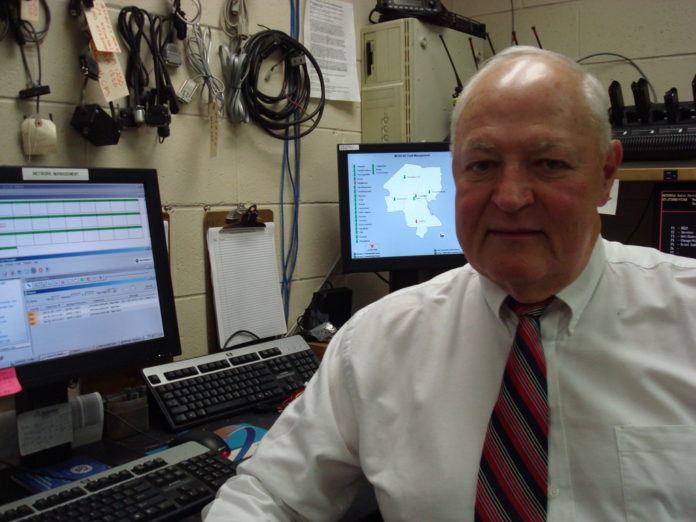
Joseph McGarry is the deputy director of public safety communications for Providence. He recently spoke to PBN about broadband coverage and the importance of connecting to the OSHEAN network.
PBN: Rhode Island always fares well in rankings of broadband coverage and speed. What are Providence biggest challenges in terms of connectivity?
MCGARRY: The biggest challenge to providing connectivity within the city is cost. There is an abundance of fiber throughout the city but the cost to lease these lines through one of the local commercial providers is cost prohibitive.
PBN: What has Providence done to prepare for a possible disaster? What are the most critical elements to the city?
MCGARRY: The city has made huge strides in preparing for a disaster. We have completely renovated the city’s Communications (E911) Center adding a [new] Computer Aided Dispatch and Records Management System, and built a five site 800 MHz Interoperable and Redundant Radio/Microwave System that is now part of the State of Rhode Island RISCON System. This system allows for seamless interoperable communications anywhere in the state. This was specifically intended to address the problems we experienced with the Station Nightclub fire where most of the responding agencies were out of range of their home radio systems and had no means to communicate with the incident commander on the site. Now with this new system any agency, including those responding from outside the state, has the ability to communicate. All these sites are connected via city/state owned microwave towers with backup generators to lessen dependence on commercial infrastructure.
The city has also implemented the Motorola MESH Mobile Data Network, a wireless network consisting of more than 500 routers and access points across the city. The system connects the hundreds of police, fire and other public safety vehicles and laptops, providing secure access to the dispatch/records management system and the NCIC computer systems (to run wants and warrants).
Communications has also installed a backup dispatch center at the Providence Emergency Management Agency facility should we ever have to abandon the main communications center. All these centers have generators.
PBN: What other achievements has the city made, in terms of information technology, in the past year?
MCGARRY: This year, communications is expanding the MESH Mobile Data Network to improve coverage; installing video surveillance cameras along Amtrak and the Providence Worcester Railroad rights of way, and upgrading the telephone infrastructure.
We continue to work with IT consulting firm Broad Reach to implement our long range network plan. Key elements there include: expanding the capacity of the network to most locations, improving reliability and redundancy in critical locations, converging redundant voice and data networks, and wherever possible deploying technologies that don’t rely on costly leased circuits.
PBN: I understand that Providence is connecting to OSHEAN and Fibertech’s networks. What can you tell us about these networks and why did Providence choose them?
MCGARRY: Over the last five years, the city of Providence, and specifically the Public Safety Department, has placed a greater emphasis on interoperability and creating systems that better link information, improve communications and provide more reliability for our mission-critical applications.
We employ several layers of connectivity, and use a mix of city-owned cable and wireless equipment, as well as leased circuits from local carriers such as Cox, Verizon and Fibertech.
We have services from Fibertech for our disaster recovery, planning and Internet access. We leveraged Fibertech’s 200 mile network throughout Providence County because they provided us with a competitively priced solution for private fiber network connectivity that is not shared or distributed among other customers. These connections provide us with a unique level of diversity and security, and support our bandwidth needs now and well into the future.
Providence recently partnered with OSHEAN to obtain a Federal BTOP Grant and as part of that process has joined the OSHEAN Network. OSHEAN provides a tremendous amount of fiber bandwidth to just about every Hospital, College, Public School and state and local government throughout the State. OSEHEAN as part of our partnership will provide fiber connectivity to several of our outlying departments, and allow for robust, redundant connectivity to important core locations throughout the City.
The emphasis today with Public Safety involves interoperability and information sharing. By tapping into the OSHEAN and Fibertech Networks, we gain access to all these sites throughout the state. This means we can share voice, data and video from organizations like R.I. EMA, Providence EMA, E911, the R.I. State Police, and the R.I. Traffic Management Center. This allows us to jointly assess a developing situation and respond with the appropriate resources.
One last reason for going with these organizations is cost. To connect the hundreds of sites we need to access just within the city would be cost prohibitive if we relied solely on leased services from the local exchange carriers.
PBN: How has public safety communications changed over the years? What will be the challenges over the next five years?
MCGARRY: One-hundred years ago, public safety communications was basically a fire alarm cable run throughout the city, and connected to fire alarm boxes and police call boxes.
Over the years it has evolved to where we have a 7X24 E-911 Center with computerized dispatch and records management system; an interoperable mobile radio system that allows a first responder to talk to anyone anywhere in the state (and soon anywhere in Rhode Island, Massachusetts and Connecticut); a MESH Mobile Data Systems to allow officers to spend more time in the field doing their jobs; video surveillance cameras located throughout the bay/ports, and currently we’re installing video surveillance cameras on key portions of the AMTRAK and Providence Worcester Rail Road rights of way. Once these projects are complete this data can be shared with other agencies over the Fibertech and OSHEAN networks.
As far as changes coming over the next 5 years I think we will see more evolutionary rather that revolutionary change. The 800 MHz Radios are evolving to be smarter, use less bandwidth (narrow banding) and provide better audio quality. The Mesh Network with be evolving to more LTE-type technology requiring fewer routers and access points, and the telephone systems are moving to voice over Internet protocol (VoIP), more closely coupling the computer and the phone and replacing the old copper wire infrastructure with fiber.












